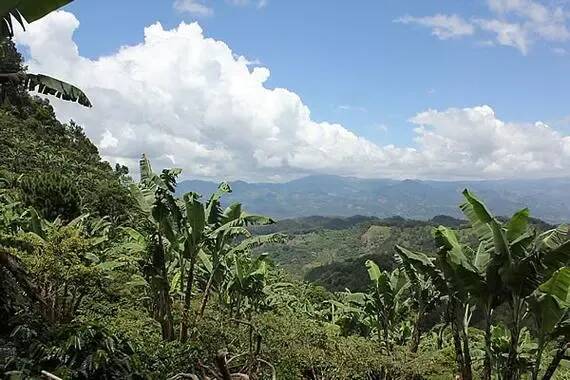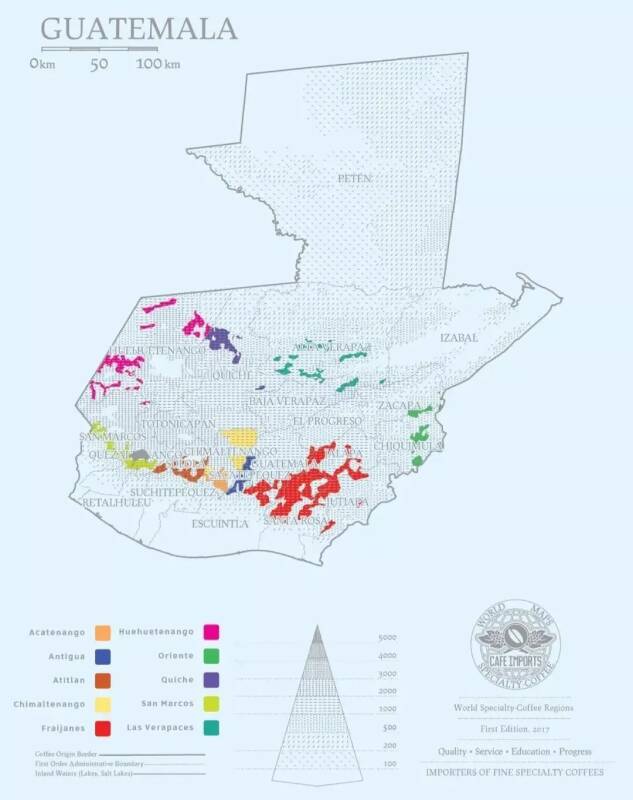Guatemala coffee beans| Introduction to Washed Coffee Beans in the South Fruit Region
Coffee is grown in many countries on all continents in the world, while in Central America, coffee is grown in many countries, such as Guatemala, Panama, Costa Rica, Honduras and so on. It is famous for its high-quality alpine hard beans and has become the ninth largest coffee producer in the world.
Guatemala
Located in the south of North America, Guatemala is a land and sea country. Bordering Mexico, Belize, Honduras and El Salvador, it is bordered by the Gulf of Honduras in the Caribbean Sea to the east and the Pacific Ocean to the south.

Guatemala is 2/3 mountains and plateaus, the west and south belong to the volcanic belt, with more than 30 volcanoes, of which Tahumurco volcano is 4211 meters above sea level, the highest peak in Central America. Because it is located in the tropics, the north and east belong to the tropical rain forest climate, the south belongs to the subtropical climate, the year is divided into two dry and wet seasons. Guatemala, with its tropical rain forest, abundant Rain Water, volcanic soil and changeable microclimate, brings elegant and lively acidity, clean taste and layered flavor to Guatemalan coffee beans.
Vivette south fruit producing area
Coffee is grown in 20 of Guatemala's 22 provinces. Eight of them are well-known, divided into five volcanic producing areas and three non-volcanic producing areas, and coffee is planted at an average elevation of more than 1500 meters. Non-volcanic areas include Vivette Nanguo (Huehuetenango), Coban (Coban) and New Oriental (Nuevo Oriente). Volcanic areas include Atitlan, Antigua, Acatenango, Fraijanes and San Marcos. Vivette Nanguo and Antigua are more famous, while New Oriental is a relatively new producing area. at present, Qianjie Coffee also has a rose summer coffee bean from the New Oriental producing area, with imported taffy sweetness, sweet orange and bergamot flavor, slightly sour, honey-like taste, soft and smooth.

Vivette Nanguo (Huehuetenango) is a non-volcanic and one of the highest producing areas in Guatemala. The name comes from Nahuatl, which means the land of the ancients (or ancestors). Vivette Nanguo is located in the western part of the country at the foot of Cuchumatanes in the Kuchu Matanes Mountains, the highest non-volcanic mountain range in Central America. Due to the large amount of hot air blowing towards the mountains from the tropical plains of Tehuantepec in Tavasco, Mexico, the coffee producing area is protected from frost and allows coffee to be planted higher, and the region has many river waters, making it an ideal growing area to cultivate quality coffee.
Bourbon, Kaddura, Kaduai
Bourbon Bourbon is one of the most important Arabica varieties in coffee culture and genetics. Although the yield of bourbon is relatively low and is prone to major diseases of coffee plants, it is famous for its excellent quality and growing at high altitudes. Kaddura is a variety of bourbon, and because of a single gene mutation, the plant grows smaller, can be planted more densely, and has the same excellent quality as bourbon. Kaduai Catuai is a hybrid between the highly productive New World Mundo Novo and Kaddura Caturra. It is a variety produced by the Institute of Agronomy of the State of Sao Paulo (IAC) in Campinas, Brazil. Kaduai has the characteristics of high productivity and small size, so it can be planted intensively. Because of these high yields and suitable for high altitude cultivation, they are very suitable for planting in the highlands of Guatemala, and these varieties are currently grown in Brazil, Honduras, Guatemala and other countries.
Bourbon Kaddura Kaduai
Introduction to Qianjie Coffee selected dangerous Mavite South Fruit Water washed Coffee Bean producing area: Vivette South Fruit area altitude: 1500-2000 m varieties: bourbon Kaddura Kaduai treatment: washing flavor: citrus lemon berry nut tea feeling
The Guatemalan Vivette South Fruit Coffee beans in Front Street Coffee are washed and moderately roasted. The front street will be boiled at a water temperature of 92 degrees. The entrance will have slight acidity, with citrus, berry and nut flavors, a soft taste and a tea finish.
Important Notice :
前街咖啡 FrontStreet Coffee has moved to new addredd:
FrontStreet Coffee Address: 315,Donghua East Road,GuangZhou
Tel:020 38364473
- Prev

Why can't the flowers come out? Latte coffee pull flowers detailed tutorial
Coffee pull flowers, there is always a magic, so that people watching fascinated, so that people learning head. For many beginners who have just started, the most fulfilling thing is the first shaped pull flower pattern, although not perfect, but also enough to have the confidence to learn, continue to practice repeatedly playing milk foam, fusion,
- Next

Starbucks olive oil coffee is actually "curry soup"?
▲ Click attention| Coffee Workshop Since "Star Dad"Howard personally promoted olive oil coffee entering the Chinese market for a week, many consumers either want to feel the special features of Starbucks "epoch-making"new products, or want to experience the "intestinal speed skating"urban legend
Related
- Being chased out of the rain in front of Starbucks?! Store: Sheltering from rain under umbrellas poses a safety hazard
- The white moonlight has changed?! Lucky launches "Big Winter Pear American"
- Hand-brewed coffee three-stage method, high-sweet and universal brewing method to share! What does the high sweet water level of hand-brewed coffee mean?
- What is the difference between raw, refined and full espresso coffee? How to extract espresso and taste good?
- A complete list of coffee bean names and their meanings! What is Yejia Shefi coffee? Where is Mantelin coffee?
- What grade does Arida Manor Kaduai coffee beans belong to? What treatment is Arida ASD slow anaerobic sun exposure?
- The milk tea cup becomes smaller?! Overlord Tea Girl launches a new "Return to Yunnan" series
- Accused of selling counterfeit and high-priced coffee beans! Well-known boutique coffee brand "Oukelao" bowed and apologized!
- How to make espresso dumplings? Can I eat coffee and glutinous rice balls together?
- Save the unformed and stagnant powder cakes in one second! What is the problem with stagnant water in the powder bowl of the espresso machine?

